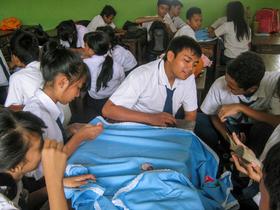For the 2025-26 school year, there is 1 public school serving 79 students in Greenwich, NJ.
The top-ranked public school in Greenwich, NJ is Morris Goodwin School. Overall testing rank is based on a school's combined math and reading proficiency test score ranking.
Greenwich, NJ public school have an average math proficiency score of 45% (versus the New Jersey public school average of 38%), and reading proficiency score of 55% (versus the 49% statewide average). Schools in Greenwich have an average ranking of 6/10, which is in the top 50% of New Jersey public schools.
Minority enrollment is 29% of the student body (majority Black), which is less than the New Jersey public school average of 62% (majority Hispanic).
Best Public Schools in Greenwich, NJ (2025-26)
School
(Math and Reading Proficiency)
(Math and Reading Proficiency)
Location
Quick Facts
Rank: #11.
Morris Goodwin School
(Math: 40-49% | Reading: 50-59%)
Rank:
Rank:
6/
Top 50%10
839 Ye Greate Street
Greenwich, NJ 08323
(856) 451-5513
Greenwich, NJ 08323
(856) 451-5513
Gr: PK-8 | 79 students Student-teacher ratio: 8:1 Minority enrollment: 29%
Frequently Asked Questions
What are the top-ranked public schools in Greenwich, NJ?
The top-ranked public schools in Greenwich, NJ include Morris Goodwin School.
How many public schools are located in Greenwich?
1 public schools are located in Greenwich.
What is the racial composition of students in Greenwich?
Greenwich public schools minority enrollment is 29% of the student body (majority Black), which is less than the New Jersey public schools average of 62% (majority Hispanic).
Recent Articles

School Vouchers: Updated Pros and Cons (2025 Review)
Comprehensive 2025 analysis of school vouchers, weighing benefits and challenges for families, funding, outcomes, and policy directions.

Benefits and Drawbacks of Homework in 2025
Explore updated 2025 insights on homework鈥檚 benefits, drawbacks, mental health impact, best practices, and policy trends in U.S. public schools.

Charter Schools vs Public Schools 2025: Key Differences & Trends
Explore updated 2025 insights comparing charter schools vs public schools, enrollment, academic outcomes, funding, and real-world examples for families and educators.
